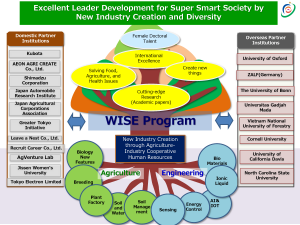Using collaboration between agricultural and industrial fields to solve social problems
The objective of the Tokyo University of Agriculture and Technology (TUAT) WISE Program is to foster PhD degree holders who will create new industries/fields through the collaboration of agriculture and engineering. An example is the development of human resources who can apply advanced engineering technologies such as artificial intelligence, information control (AI, IoT), robotics, advanced measurement, mobility (automatic driving, distribution systems), and energy control to the field of agriculture, accelerate the implementation of smart agriculture based on ICT and symbiosis with nature (water, air, soil, weather), create a safe, secure and innovative “smart food chain system”, and ultimately contribute to improving national happiness. In addition to the application of engineering technology to the field of agriculture, we can also consider the construction of “energy production and environmental purification systems using biological systems” through the collaborative creation of engineering with agricultural science fields such as microorganisms and plants, and the construction of “smart livestock diagnostic systems” through the collaborative creation of veterinary medicine and engineering. The University defines the creation of new industries as “the creation of new fields through the cutting-edge research cooperation in both agriculture and engineering.” To this end, we train advanced doctoral students who can realize this goal through bold conceptualization of the future and steady, step-by-step implementation of their ideas. An educational system with the commitment of the industrial circle is indispensable for the realization of this graduate program. A Consortium for the Creation of New Industries is formed with the participation of businesses and other organizations as partner institutions, and leaders will be developed through the cooperation of government, industry and academia. At present, there are 11 domestic and 8 overseas partner institutions participating in the Consortium.


